Influence of Composite C-S-H Seed Prepared by Wet Grinding on High-Volume Fly Ash Concrete
Abstract
1. Introduction
2. Materials and Methods
2.1. Raw Materials
2.2. Sample Preparation
2.2.1. Preparation of C-Seed
2.2.2. Preparation of Concrete
2.3. Test Methods
2.3.1. Composite C-S-H Seed Particle Size
2.3.2. Compressive Strength (CS) Test
2.3.3. X-Ray Powder Diffraction (XRD) Analysis
2.3.4. Scanning Electron Microscope (SEM) Analysis
2.3.5. Thermal Gravimetric (TG) Analysis
2.3.6. Pore Structure Analysis BET (Brunauer–Emmett–Teller)
2.3.7. Nuclear Magnetic Resonance Spectroscopy (NMR) Analysis
3. Results and Discussion
3.1. Composite C-Seed Particle Size Distribution
3.2. XRD of Composite C-Seed
3.3. Compressive Strength (CS)
3.4. XRD of Concrete
3.5. TG Analysis of Concrete
3.6. Analysis of Concrete Pore Structure
3.7. NMR Analysis of Concrete
4. Conclusions
- The wet grinding process can be used to prepare composite nucleating agents from a mixture of cement and silica fume. The particle size of the composite C-seed agent can be decreased to less than 3.9 μm, indicating that wet grinding can effectively improve the fineness of the C-seed. With an increase in SF content, the particle size of the C-seed agent decreases to 0.66 μm. During wet grinding, C-S-H and CH are produced. As the SF content increases, SF reacts with CH to produce C-S-H, but as the C/S ratio decreases further, the content of C-S-H produced begins to decrease, and unhydrated SF appears. As there are few studies on wet grinding C-S-H seed and its key parameters, such as grain size and hydration degree, further research on this subject is necessary.
- Adding a composite C-seed can improve the compressive strength of concrete in both the early (1 d) and late (28 d) stages; in this study, the resulting compressive strength was higher than that of the Control. However, the difference is that the short-term compressive strength at 1 d gradually decreases with the increase in SF content in the composite C-seed, while the compressive strength at 28 d increases with the increase in SF content in the composite C-seed.
- The addition of a composite C-seed reduces the number of harmful pores in concrete, and the nucleation effect of the composite nucleating agents can accelerate cement hydration, producing large amounts of C-S-H and CH. CH further stimulates the hydration of fly ash to produce C-S-H, which fills the concrete and makes its structure denser. With this improvement in pore structure, the degree of carbonation in the concrete diminishes, showing that concrete can resist corrosion due to carbon dioxide. Therefore, conducting durability-related research on concrete containing C-seed with different C/S ratios is imperative.
- XRD, NMR and TG test results show that the addition of a composite C-seed agent promotes the short-term strength of high-volume fly ash concrete. As the C-seed agent induces cement hydration, a large amount of CH is produced, which then undergoes a secondary hydration reaction with the fly ash, improving the short-term strength of the concrete. Therefore, as the C/S ratio in the composite C-seed decreases, the C-seed content in the composite C-seed decreases, resulting in a gradual decrease in the hydration of the concrete at 1 d and a reduction in CH production, which affects the secondary hydration of fly ash.
Author Contributions
Funding
Data Availability Statement
Conflicts of Interest
References
- Blotevogel, S.; Doussang, L.; Poirier, M. The influence of Al2O3, CaO, MgO and TiO2 content on the early-age reactivity of GGBS in blended cements, alkali-activated materials and supersulfated cements. Cem. Concr. Res. 2024, 178, 107439. [Google Scholar] [CrossRef]
- Jiang, J.; Miao, Y.; Wang, H. In-situ dispersion of nano-TiO2 to highly reinforce cement paste. Constr. Build. Mater. 2023, 409, 133962. [Google Scholar] [CrossRef]
- Abo-El-Enein, S.; El-Hosiny, F.; El-Gamal, S. Gamma radiation shielding, fire resistance and physicochemical characteristics of Portland cement pastes modified with synthesized Fe2O3 and ZnO nanoparticles. Constr. Build. Mater. 2018, 706, 173687. [Google Scholar] [CrossRef]
- Han, B.; Wang, Z.; Zeng, S. Properties and modification mechanisms of nano-zirconia filled reactive powder concrete. Constr. Build. Mater. 2017, 434, 141426. [Google Scholar] [CrossRef]
- Marrero, R.; Corr, J.; Espinosa, H.; Shah, S. Characterization of adhesion strength between carbon nanotubes and cementitious materials. Cem. Concr. Compos. 2023, 138, 104953. [Google Scholar] [CrossRef]
- Reches, Y. Nanoparticles as concrete additives: Review and perspectives. Constr. Build. Mater. 2018, 495, 175483. [Google Scholar] [CrossRef]
- Uthaman, S.; Vishwakarma, V.; George, R. Enhancement of strength and durability of fly ash concrete in seawater environments: Synergistic effect of nanoparticles. Constr. Build. Mater. 2018, 459, 187448. [Google Scholar] [CrossRef]
- Tao, M.; Qiang, Y.; Hu, A. Effect of compound nano-CaCO3 addition on strength development and microstructure of cement-stabilized soil in the marine environment. Constr. Build. Mater. 2017, 81, 151775. [Google Scholar]
- Li, W.; Wang, R.; Wang, Y.; Zuo, W. The acceleration effect of nano C-S-H-PCE on the microstructure formation and evolution at early age of cement paste. Mater. Struct. 2023, 56, 4. [Google Scholar] [CrossRef]
- Thomas, J.; Hamlin, M.; Jennings, J. Influence of Nucleation Seeding on the Hydration Mechanisms of Tricalcium Silicate and Cement. J. Phys. Chem. 2009, 113, 4327–4334. [Google Scholar] [CrossRef]
- Shen, X.; Feng, P.; Zhang, Y. Multi-step nucleation of C-S-H: DFT simulation on silicate oligomerization and Si(Qn) evolution dynamics. Constr. Build. Mater. 2024, 439, 137372. [Google Scholar] [CrossRef]
- Yu, J.; Wang, K.; Yang, P. Simulation of calcium carbonate nucleation processes in confined C-S-H nanopores with different calcium-silicon ratios. Constr. Build. Mater. 2024, 438, 137157. [Google Scholar] [CrossRef]
- Li, Y.; Tang, E. Research on C-S-H and C-S-H Dehydration Relative to Cement Stone Structure Modification. J. Ceram. 1991, 4, 373–380. [Google Scholar]
- Li, J.; Tang, E. Effect of synthetic C-S-H gel on the interface zone between cement stone and aggregate. J. Wuhan Univ. Technol. 1997, 2, 9–12. [Google Scholar]
- Panithi, W.; Pitipak, B.; Wanwisa, K. Synthesis of low crystalline thermally insulating calcium silicate hydrate via a simple template-assisted sol–gel method. Constr. Build. Mater. 2022, 353, 129081. [Google Scholar]
- Tian, H.; Stephan, D.; Lothenbach, B. Influence of foreign ions on calcium silicate hydrate under hydrothermal conditions: A review. Constr. Build. Mater. 2021, 301, 124071. [Google Scholar] [CrossRef]
- Chen, G.; Lin, M.; Chen, Y. Alkali-reinforced hydrothermal solidification of waste soil. Mater. Chem. Phys. 2022, 289, 126505. [Google Scholar] [CrossRef]
- Li, M.; Tan, H.; He, X. Preparation of nano cement particles by wet-grinding and its effect on hydration of cementitious system. Constr. Build. Mater. 2021, 307, 125051. [Google Scholar] [CrossRef]
- Ji, G.; Peng, X.; Wang, S. Influence of ground quartz sand finesses on the formation of poorly ordered calcium silicate hydrate prepared by dynamically hydrothermal synthesis. Case Stud. Constr. Mater. 2024, 20, e02746. [Google Scholar] [CrossRef]
- Gu, X.; Tan, H.; He, X. Nano C-S-H seeds prepared from ground granulated blast-furnace slag-carbide slag and its application in Portland cement. Constr. Build. Mater. 2022, 329, 127204. [Google Scholar] [CrossRef]
- Yang, J.; Zeng, J.; He, X. Sustainable clinker-free solid waste binder produced from wet-ground granulated blast-furnace slag, phosphogypsum and carbide slag. Constr. Build. Mater. 2022, 330, 127218. [Google Scholar] [CrossRef]
- Li, Y.; Fang, J.; Cheng, L. Mechanical performance, hydration characteristics and microstructures of high volume blast furnace ferronickel slag cement mortar by wet grinding activation. Constr. Build. Mater. 2022, 320, 126148. [Google Scholar] [CrossRef]
- Wang, Y.; Tan, H.; Gu, X. Preparation of nano-kaolin by wet-grinding process and its application as accelerator in Portland cement. J. Build. Eng. 2021, 44, 103401. [Google Scholar] [CrossRef]
- Liu, X.; Ma, B.; Tan, H. Preparation of ultrafine fly ash by wet grinding and its utilization for immobilizing chloride ions in cement paste. Waste Manag. 2020, 113, 456–468. [Google Scholar] [CrossRef] [PubMed]
- Yang, J.; Yang, M.; He, X. Green reaction-type nucleation seed accelerator prepared from coal fly ash ground in water environment. Constr. Build. Mater. 2021, 306, 124840. [Google Scholar] [CrossRef]
- Tan, H.; Du, H.; Li, M. Enhancement of compressive strength of high-volume fly ash cement paste by wet grinded cement: Towards low carbon cementitious materials. Constr. Build. Mater. 2022, 323, 126458. [Google Scholar] [CrossRef]
- Feng, X.; Zhuo, C.; Yin, S. Synthesizing high-quality C-S-H seeds using the impinging stream precipitation method. J. Sustain. Cem.-Based Mater. 2024, 13, 841–853. [Google Scholar] [CrossRef]
- Deng, X.; Tan, H.; Yang, Z. C-S-H based nucleation seed prepared from waste glass powder and carbide slag and its application in Portland cement. Constr. Build. Mater. 2024, 416, 135258. [Google Scholar] [CrossRef]
- GB/T 31387-2015; Reactive Power Concrete. Standardization Administration of the People’s Republic of China: Beijing, China, 2015.
- Luc, N.; Alexander, E.; Matthias, K. A kinetic analysis of the role of polymers in mineral nucleation. The exampleof gypsum. Cem. Concr. Res. 2019, 124, 105837. [Google Scholar]
- Zheng, S.; Liu, T.; Jiang, G.; Wen, D.; Dai, T.; Yang, G.; Gu, H.; Fang, C. Direct evidence of pore structural effects on the compressive strength of lightweight cement slurry containing nano silica fume and hollow glass microspheres. Constr. Build. Mater. 2024, 411, 134703. [Google Scholar] [CrossRef]
- Basit, M.; Nasir, S. Enhancing the mechanical and environmental performance of engineered cementitious composite with metakaolin, silica fume, and graphene nanoplatelets. Constr. Build. Mater. 2023, 404, 133187. [Google Scholar]
- Pao, R.; Oh, T.; Kim, W. Enhanced microstructure and mechanical properties of cementless ultra high performance fiber-reinforced alkali activated concrete with silicon dioxide nanoparticles. Constr. Build. Mater. 2023, 398, 132514. [Google Scholar] [CrossRef]
- Liu, H.; Sun, X.; Du, H. Effects and threshold of water film thickness on multi-mineral cement paste. Cem. Concr. Compos. 2020, 112, 103677. [Google Scholar] [CrossRef]
- Lei, F.; Lei, L.; Kang, Y. Effect of 2-acrylamide-2-methylpropane sulfonic acid on the early strength enhancement of calcium silicate hydrate seed. Cem. Concr. Compos. 2024, 149, 105527. [Google Scholar] [CrossRef]
- Zhang, Z.; Feng, Q.; Zhu, W. Influence of Sand-Cement Ratio and Polycarboxylate Superplasticizer on the Basic Properties of Mortar Based on Water Film Thickness. Materials 2021, 14, 4850. [Google Scholar] [CrossRef] [PubMed]
- Zhang, J.; Ma, Y.; Wang, J. A novel shrinkage-reducing polycarboxylate superplasticizer for cement-based materials: Synthesis, performance and mechanisms. Constr. Build. Mater. 2022, 321, 126342. [Google Scholar] [CrossRef]
- Kanchanason, V.; Plank, J. Role of pH on the structure, composition and morphology of C-S-H-PCE nanocomposites and their effect on early strength development of Portland cement. Cem. Concr. Res. 2017, 102, 98. [Google Scholar] [CrossRef]
- Plank, J.; Hirsch, C. Impact of zeta potential of early cement hydration phases on superplasticizer adsorption. Cem. Concr. Res. 2007, 37, 537–542. [Google Scholar] [CrossRef]
- Liu, L.; Sun, C.; Geng, G. Influence of decalcification on structural andmechanical properties of synthetic calcium silicate hydrate. Cem. Concr. Res. 2019, 123, 105793. [Google Scholar] [CrossRef]
- Garcia, I.; Goracci, G.; Dolado, J. Mineralogical and microstructural alterations in a portland cement paste after an accelerated decalcification proces. Cem. Concr. Res. 2021, 140, 106312. [Google Scholar] [CrossRef]
- Anoni, G.; Haach, G.; Khazanovich, L. Image reconstruction in concrete ultrasound tomography: A systematic review. Constr. Build. Mater. 2024, 441, 137472. [Google Scholar] [CrossRef]
- Liu, X.; Si, Z.; Huang, L. Performance of concrete under a low-pressure environment. Constr. Build. Mater. 2025, 461, 139862. [Google Scholar] [CrossRef]
- Zhao, D.; Xu, J.; Han, Z. Study on the correlation between pore structure characterization and early mechanical properties of foamed concrete based on X-CT. Constr. Build. Mater. 2024, 450, 138603. [Google Scholar] [CrossRef]
- Xu, J.; Zhao, D.; Wang, S. Quantitative analysis of pore structure’s impact on early mechanical properties and durability of foam concrete: Macroscopic and mesoscopic insights. Constr. Build. Mater. 2025, 459, 139775. [Google Scholar] [CrossRef]
- Wang, Y.; He, F.; Wang, J. Effects of Calcium Bicarbonate on the Properties of Ordinary Portland Cement Paste. Constr. Build. Mater. 2019, 225, 591–600. [Google Scholar] [CrossRef]
- Kaya, K.; Yilmaz, K.; Karahan, O. Mechanical properties of class C and F fly ash geopolymer mortars. Gradevinar 2020, 72, 297–309. [Google Scholar]
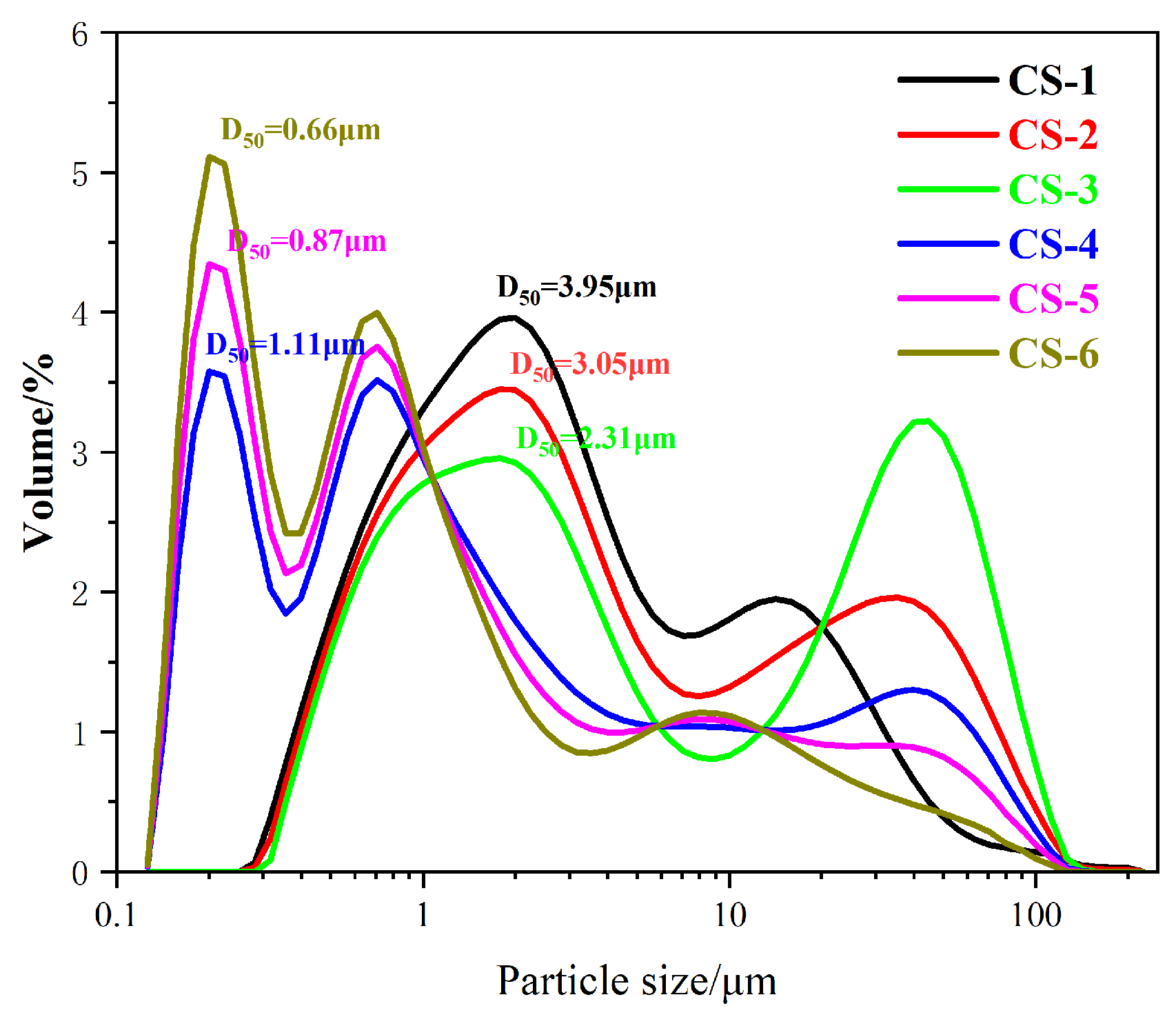
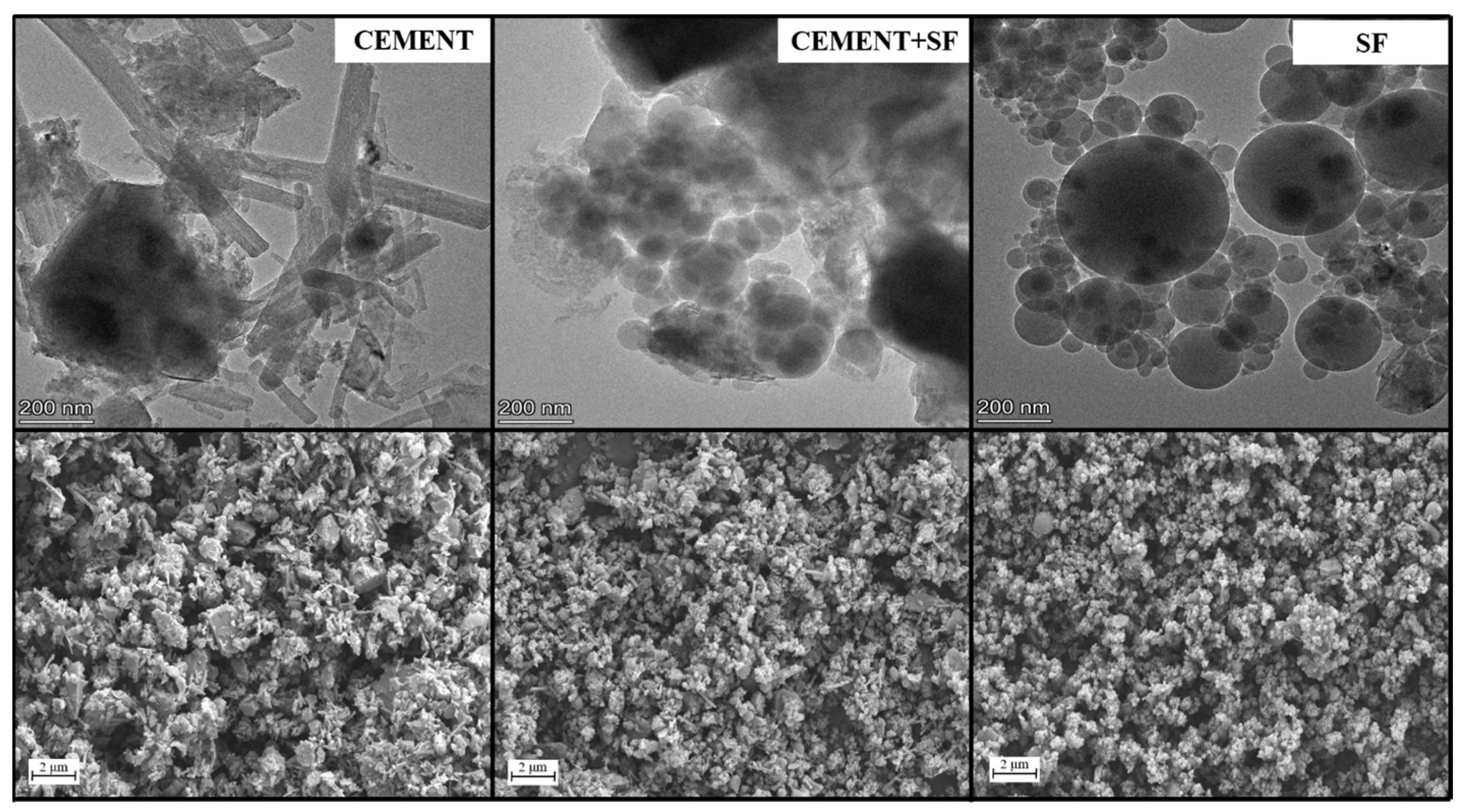


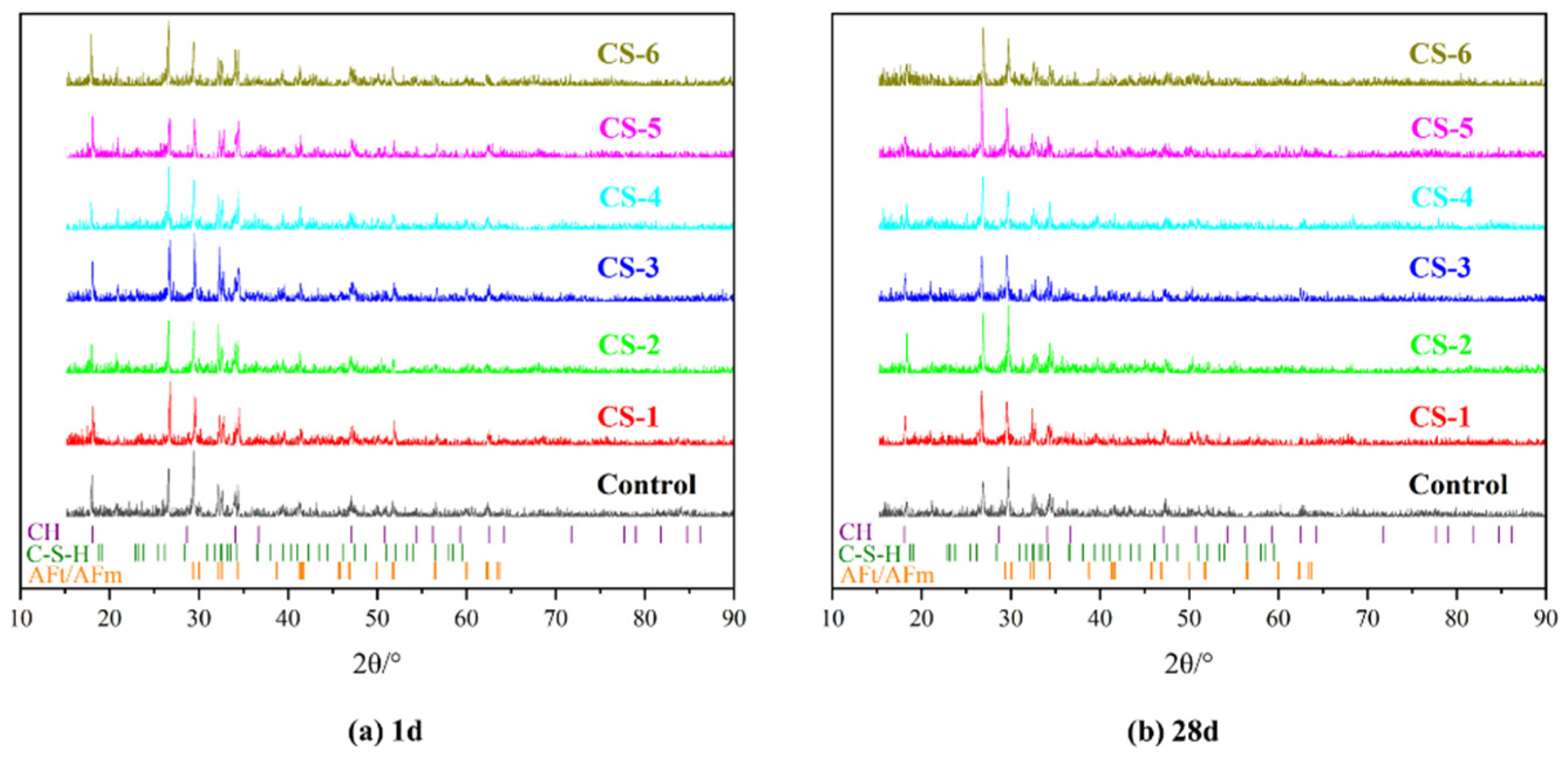

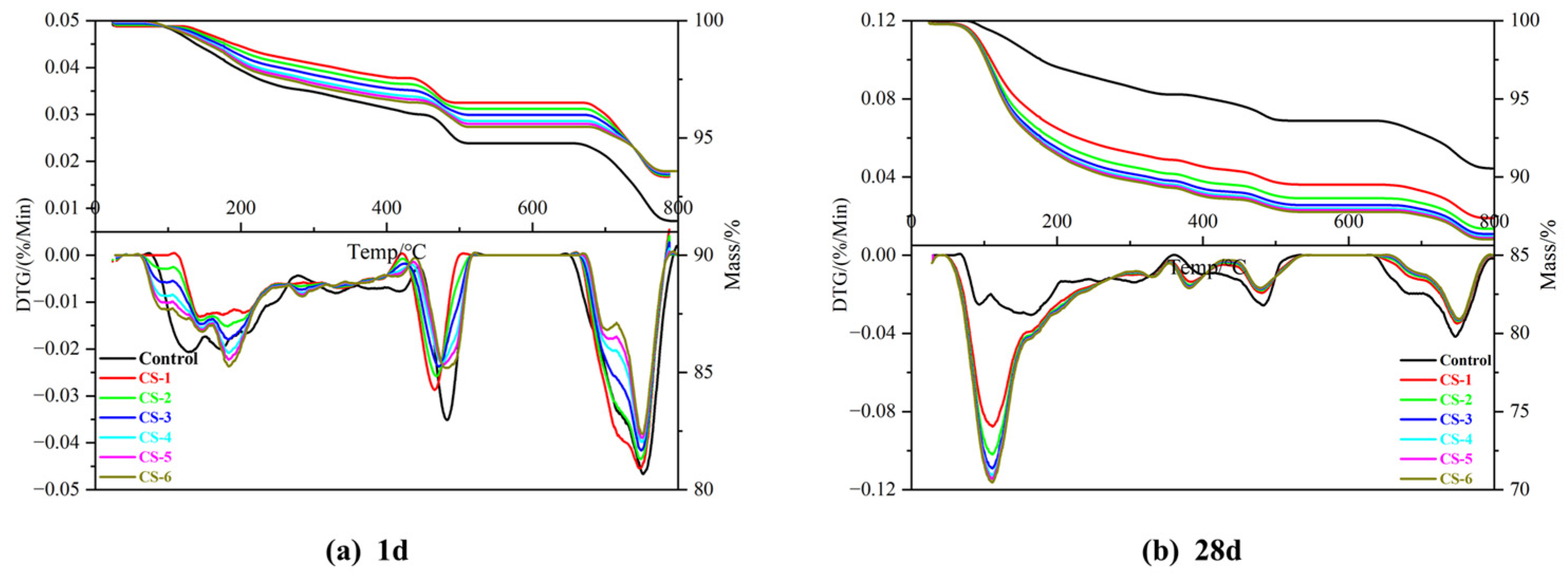
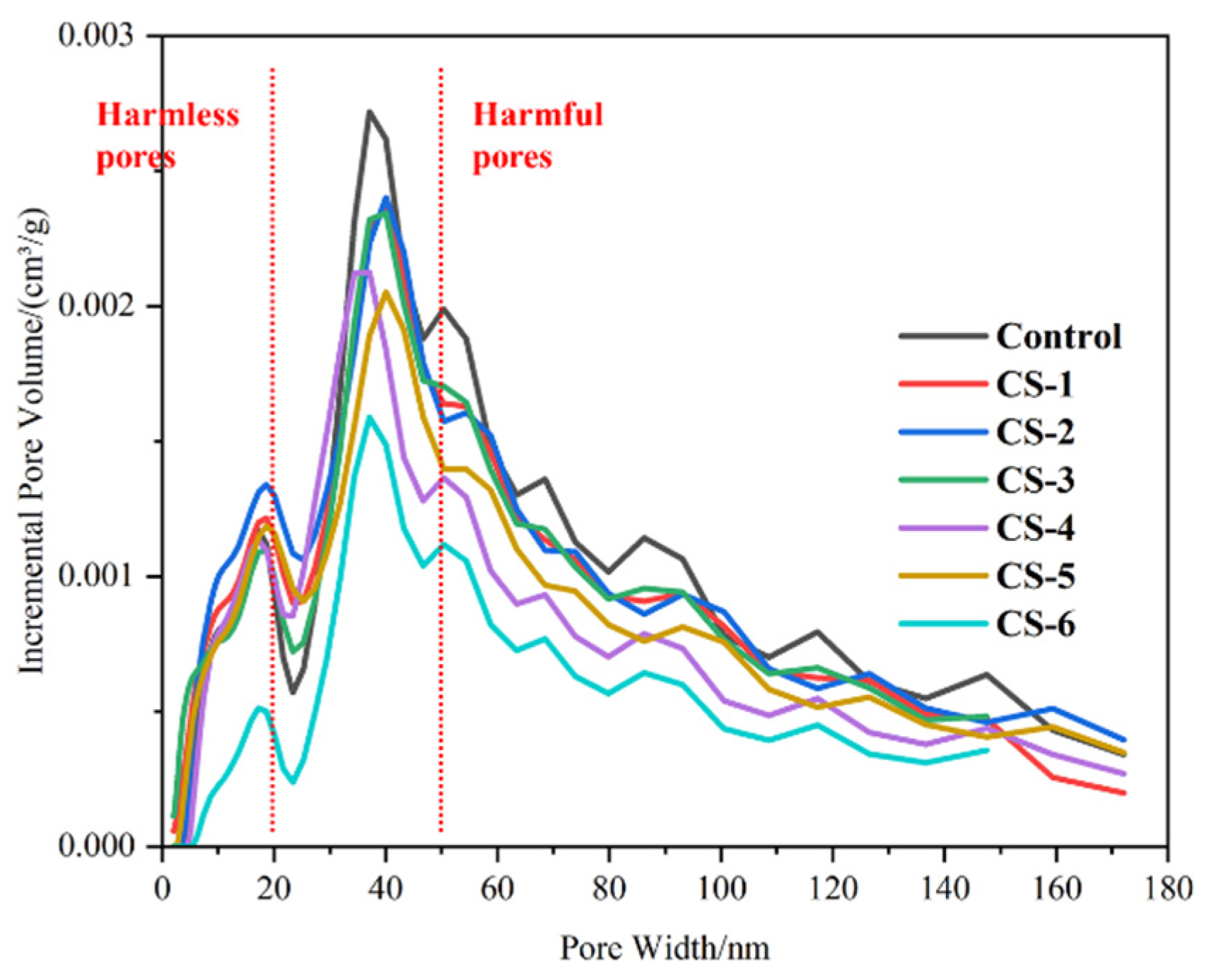
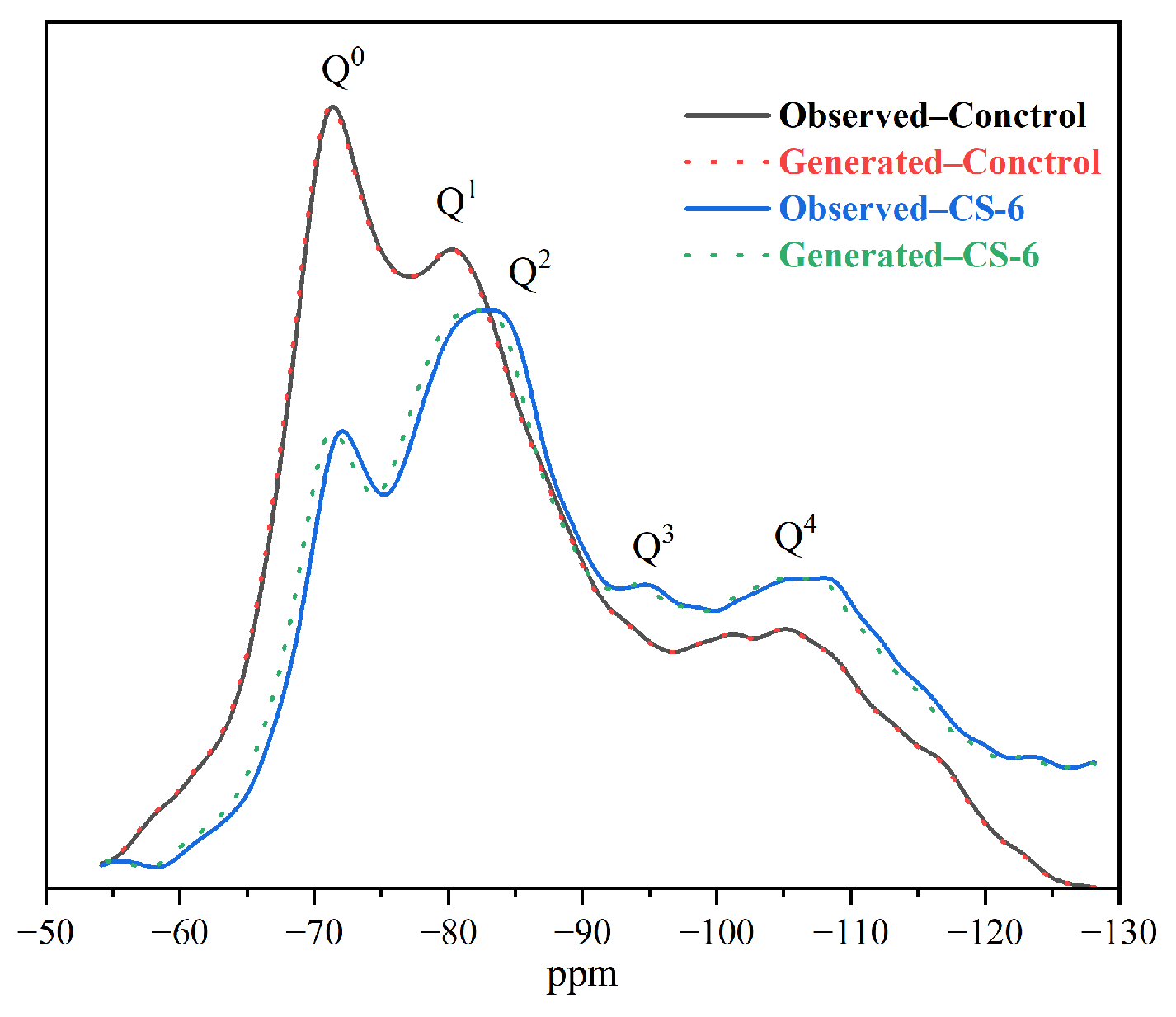
| Sample | SiO2 | Al2O3 | CaO | Fe2O3 | SO3 | MgO | Loss |
|---|---|---|---|---|---|---|---|
| Cement | 22.81 | 4.52 | 61.96 | 3.43 | 2.84 | 2.62 | 1.81 |
| FA | 52.52 | 25.32 | 9.53 | 4.59 | 1.53 | 1.39 | 0.51 |
| SF | 90.30 | 1.11 | 3.07 | 5.01 | 0.11 | 0.73 | 0.04 |
| Sample | CS-1 | CS-2 | CS-3 | CS-4 | CS-5 | CS-6 |
|---|---|---|---|---|---|---|
| Cement | 100 | 80 | 60 | 40 | 20 | 0 |
| SF | 0 | 20 | 40 | 60 | 80 | 100 |
| Sample | Cement | FA | Sand | Stone | Water |
|---|---|---|---|---|---|
| Control | 280 | 90 | 820 | 1020 | 160 |
| CS-1 | 240 | 130 | 820 | 1020 | 160 |
| CS-2 | 240 | 130 | 820 | 1020 | 160 |
| CS-3 | 240 | 130 | 820 | 1020 | 160 |
| CS-4 | 240 | 130 | 820 | 1020 | 160 |
| CS-5 | 240 | 130 | 820 | 1020 | 160 |
| CS-6 | 240 | 130 | 820 | 1020 | 160 |
Disclaimer/Publisher’s Note: The statements, opinions and data contained in all publications are solely those of the individual author(s) and contributor(s) and not of MDPI and/or the editor(s). MDPI and/or the editor(s) disclaim responsibility for any injury to people or property resulting from any ideas, methods, instructions or products referred to in the content. |
© 2025 by the authors. Licensee MDPI, Basel, Switzerland. This article is an open access article distributed under the terms and conditions of the Creative Commons Attribution (CC BY) license (https://creativecommons.org/licenses/by/4.0/).
Share and Cite
Wang, S.; Liu, J.; Tian, Y.; Zhao, P. Influence of Composite C-S-H Seed Prepared by Wet Grinding on High-Volume Fly Ash Concrete. Buildings 2025, 15, 270. https://doi.org/10.3390/buildings15020270
Wang S, Liu J, Tian Y, Zhao P. Influence of Composite C-S-H Seed Prepared by Wet Grinding on High-Volume Fly Ash Concrete. Buildings. 2025; 15(2):270. https://doi.org/10.3390/buildings15020270
Chicago/Turabian StyleWang, Shiheng, Jianan Liu, Yaogang Tian, and Peng Zhao. 2025. "Influence of Composite C-S-H Seed Prepared by Wet Grinding on High-Volume Fly Ash Concrete" Buildings 15, no. 2: 270. https://doi.org/10.3390/buildings15020270
APA StyleWang, S., Liu, J., Tian, Y., & Zhao, P. (2025). Influence of Composite C-S-H Seed Prepared by Wet Grinding on High-Volume Fly Ash Concrete. Buildings, 15(2), 270. https://doi.org/10.3390/buildings15020270






